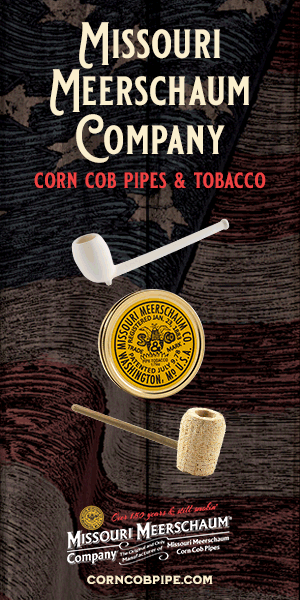I just bought some own label blends from Iwan Ries, that come in their "perma-moist" packs. Does anyone have any experience with how good these are for long term storage? I have two packs of IRC Virginia Flake ( which I understand is a good substitute ofr the Muray version of Dunhill Light Flake). I intend to opme one shortly, but I was considering cellaring the other one. Anybody have any experience with these?
Are IRC "Perma-Moist" Packs Good For Long Term Storage?
- Thread starter judcole
- Start date
You are using an out of date browser. It may not display this or other websites correctly.
You should upgrade or use an alternative browser.
You should upgrade or use an alternative browser.
SmokingPipes.com Updates
Watch for Updates Twice a Week
- Status
- Not open for further replies.
Jud, as you already know, air is the enemy of tobacco. The PM packs are fine until opened and reopened and reopened... I would suggest that once opened you put them in an absolute air-tight container or quart Mason Jar as I do. As for long term storage, I think if the PM pack remains unopened, the shelf life would be pretty good until opened. If you will store long term just put it in a Mason Jar and be done with it. I smoke the Three Star Blue in my rotation and keep it in an air-tight container. I usually buy several at a time. I don't worry about a few months if unopened. Hope this helps you.
__________________________________________________________________________________________________________________

__________________________________________________________________________________________________________________

I bought a few pounds of IRC Va Flake and just stored it in the PermaMoist bags they came in.
They have aged wonderfully over the course of several years, and have retained their moisture, oils,
resins, volatiles or whatever. The bags are completely reliable if you protect them from punctures.
Like the Captain suggests, nothing beats a Mason jar, but don't feel that you need to transfer your
tobacco from the pouches. They're great, and at only 20¢ apiece they're a viable choice for budget-minded cellaring.


They have aged wonderfully over the course of several years, and have retained their moisture, oils,
resins, volatiles or whatever. The bags are completely reliable if you protect them from punctures.
Like the Captain suggests, nothing beats a Mason jar, but don't feel that you need to transfer your
tobacco from the pouches. They're great, and at only 20¢ apiece they're a viable choice for budget-minded cellaring.


The IRC Va Flake is sharp and grassy, but the citrus zing and sweet taste is hard to beat if you're a veteran Va flake guy.
With age, the tanginess subsides a little (not what I like to see), but the sweetness becomes more caramel-like. If you're
looking for bargain Va flake in bulk, do give Altadis 507-C a try. I think I like it better than IRC.
I just opened a 5 yr. old jar of McClelland 2010 (probably the same as IRC 2010) and was disappointed by how thin the taste was. I can't understand how something as weak as 2010 became so popular. I like thick chewy smoke with solid taste. I asked Russ what I could do to increase the body and mouth feel. He advised to add some light Burley blending leaf (since I don't go in for dark fired leaf or Latakia.)
We'll see...
With age, the tanginess subsides a little (not what I like to see), but the sweetness becomes more caramel-like. If you're
looking for bargain Va flake in bulk, do give Altadis 507-C a try. I think I like it better than IRC.
I just opened a 5 yr. old jar of McClelland 2010 (probably the same as IRC 2010) and was disappointed by how thin the taste was. I can't understand how something as weak as 2010 became so popular. I like thick chewy smoke with solid taste. I asked Russ what I could do to increase the body and mouth feel. He advised to add some light Burley blending leaf (since I don't go in for dark fired leaf or Latakia.)
We'll see...
Well, I was gonna avoid mentioning the current status of my 2010 dilemma, but since you asked...
At the time Russ made that suggestion, I had a tobacco order pending at P&C.com, and I asked him to add 2 oz. of
the light Burley to the order. Since then P&C.com made a partial shipment of my order, but the Burley wasn't sent.
Maybe it'll arrive with the back ordered tins. I dunno. Frankly, right now I'm just hoping my original order gets
completed! :lol:
At the time Russ made that suggestion, I had a tobacco order pending at P&C.com, and I asked him to add 2 oz. of
the light Burley to the order. Since then P&C.com made a partial shipment of my order, but the Burley wasn't sent.
Maybe it'll arrive with the back ordered tins. I dunno. Frankly, right now I'm just hoping my original order gets
completed! :lol:
I was looking at the IRC not so much for a bargain flake, but because I have read - here, I think - that it was closer to the old Murray version of Dunhill Light Flake than the current Orlik version, Dunhill Flake, is. The old Murray version was a fave of mine. I've still got a couple of tins stashed away. :The IRC Va Flake is sharp and grassy, but the citrus zing and sweet taste is hard to beat if you're a veteran Va flake guy.
With age, the tanginess subsides a little (not what I like to see), but the sweetness becomes more caramel-like. If you're looking for bargain Va flake in bulk, do give Altadis 507-C a try. I think I like it better than IRC.
 :
:IMO, IRC Va Flake is not very close to the modern Dunhill and OGS flakes.
It is much more sassy (some would say "hot"), with fennel and wheat flavors going on behind the citrus tang.
In a way I'd say IRC is a less refined tobacco (more rough edges); but once I adjusted, it grew on me and
there's always a little in my cellar to scratch the itch -- so to speak.
It is much more sassy (some would say "hot"), with fennel and wheat flavors going on behind the citrus tang.
In a way I'd say IRC is a less refined tobacco (more rough edges); but once I adjusted, it grew on me and
there's always a little in my cellar to scratch the itch -- so to speak.
Getting back to Roth's request:
To recap, I had a 5 yr. old jar of McClelland 2010 that deepened in flavor (lots of tang and citrus flavor), but it was
so disappointing because it had no body, or mouth feel. It was flavorful, but very thin -- like weak tea.
I asked Russ Ouellette what to do and he suggested adding a light Burley. Long story short, I got some C&D White Burley
and added it at the 10% level. This is just about the right percentage to add body without turning it into a Burley-forward blend.
After smoking a couple of bowls, I decided to add 5% McClelland blending Perique, which had the effect of deepening the
flavor a bit and rounding-out some of the 2010's zestiness.
In summary, I succeeded in rescuing 160 grams of 2010; but if I had it to do all over again, I'd just buy a can of
McClelland's Beacon and call it a wash.
(Emphases mine):
BTW, G.L.Pease made an interesting comment to Ouellette's article on Burley, The Rodney Dangerfield Of Tobacco.
If/when the tobacco arrives and you've had a chance to "experiment," I'd still much appreciate your rundown on the results.
To recap, I had a 5 yr. old jar of McClelland 2010 that deepened in flavor (lots of tang and citrus flavor), but it was
so disappointing because it had no body, or mouth feel. It was flavorful, but very thin -- like weak tea.
I asked Russ Ouellette what to do and he suggested adding a light Burley. Long story short, I got some C&D White Burley
and added it at the 10% level. This is just about the right percentage to add body without turning it into a Burley-forward blend.
After smoking a couple of bowls, I decided to add 5% McClelland blending Perique, which had the effect of deepening the
flavor a bit and rounding-out some of the 2010's zestiness.
In summary, I succeeded in rescuing 160 grams of 2010; but if I had it to do all over again, I'd just buy a can of
McClelland's Beacon and call it a wash.
(Emphases mine):
BTW, G.L.Pease made an interesting comment to Ouellette's article on Burley, The Rodney Dangerfield Of Tobacco.
[Burley is] a much more important tobacco than is often thought, especially amongst the VA purists. I’ve always found that one of burley’s most interesting characteristics, when used moderately as an adjunct to a blend rather than as the blend’s base, is that it can add body and “mouth feel” to the smoke, without significantly altering the natural flavor profile of the other tobaccos in the mix. It has a fascinating chameleon-like character in these cases. When first blended, the burley’s signature is very apparent in the smoke, but within a matter of days, it takes on the flavors of the other leaf, its own almost completely disappearing into the background, while still offering that extra something. It’s really interesting stuff. -- February 8th, 2012 at 3:15 pm
Yes, it did produce the body I wanted -- body similar to Beacon's. The Va's of both blends now have a similar flavor profile because I added 5% Perique. IOW, the Burley works to provide extra body, or mouth feel.
- Status
- Not open for further replies.






